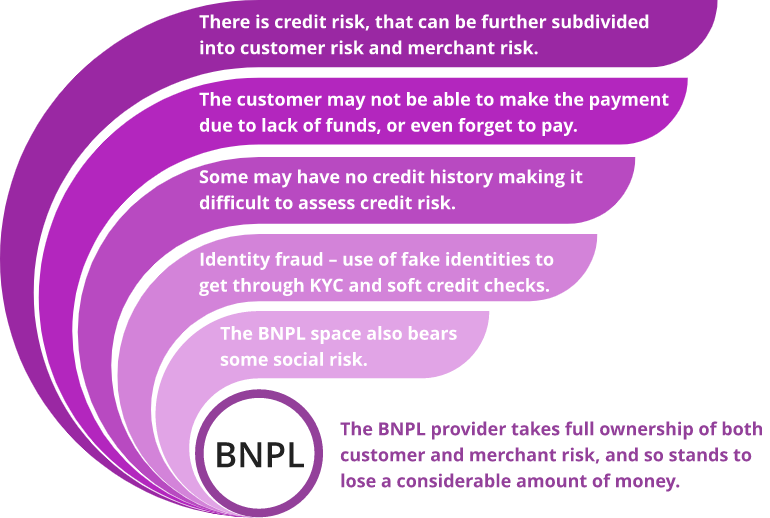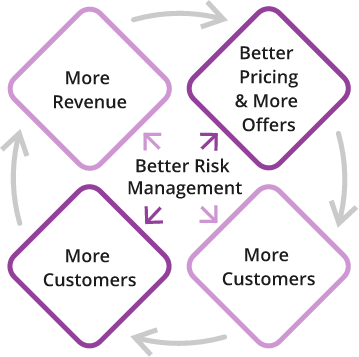

In 2012, a small and innovative venture named Affirm was launched as part of the initial portfolio of a startup incubator. By 2014, Affirm had raised more than USD 50 million in venture funding and had onboarded numerous merchant partners. This gave rise to a new phenomenon – Buy Now Pay Later (BNPL).1
Buy Now
Pay Later (BNPL)
What is BNPL?
BNPL is short-term financing for comparatively smaller amounts. It is interest-free and seamlessly integrated with the checkout process, making it attractive for customers. Most importantly authorization for this option is based on a soft credit check unlike that of credit cards and loans. Merchants too benefit from BNPL as it generates greater customer footfall and business while they get paid immediately and credit risk is owned by the provider.
Revenue for providers comes from merchant fees or commissions collected from each merchant for every transaction.This ranges between 2 percent to 8 percent of the transaction value. It comes from penalties levied on late payments and from interest on repayment. Providers also levy a marketing fee for schemes such as cost-per-click, affiliate marketing services, as well as charging a one-time processing fee to customers. Merchants pay BNPL providers a recurring administrative fee for billing, servicing, and collections. They also get interest from delayed settlements while collecting a pre-closure charge from customers.

interest-free

Benefit for Merchants

Benefit for Provider

BNPL is not without some risks.
What Are the Risks Associated with BNPL?
The BNPL ecosystem is driven by a growing number of fintechs and NBFCs (Non-Banking Financial Companies) and is not without risks. To begin with, there is credit risk, that can be further subdivided into customer risk and merchant risk. The customer may not be able to make the payment due to lack of funds or even forget to pay. Some may have no credit history making it difficult to assess credit risk. There are also several kinds of frauds being reported within this space, including synthetic identity fraud – the use of fake identities to get through KYC and soft credit checks. The BNPL provider takes full ownership of both customer and merchant risk, and so stands to lose a considerable amount of money.

The space also bears some social risks. BNPL regulatory frameworks are still evolving. The absence of regulatory checks could allow providers to take advantage of loopholes in consumer protection laws to provide illegal loans. For example, AfterPay had to pay USD 1 million to California’s Department of Business Oversight for designing products to evade consumer protection laws and loaning money without a valid license.3 Also, BNPL models are built to tap into the consumer’s urge to buy, and as such don’t encourage savings. In fact, a recent AITE Novarica BNPL survey indicates that 36 percent of consumers spent more money than before using BNPL options.4 As the segment continues to grow, the associated risks of Buy Now Pay Later will increase exponentially. If these risks are not addressed both providers and customers may end up in debt, which could lead to economic imbalance and significantly impact the global economy.
Managing the BNPL Risk
Problems
Solutions
Managing customer risk:
A multi-pronged approach to risk management and fraud protection is critical in customer credit risk management. When a customer attempts to use the BNPL option, providers must make two key decisions. First, if they are a valid user and second, how much credit limit to allocate. AI and Machine Learning can help providers assess customers’ authenticity. Some of the ways these technologies work include device tracking, IP profiling, email tracking, phone number monitoring, detecting unusual purchase behavior while also tracking shipping address inconsistencies. Maintaining consistent communication with their customers can help merchants in curbing BNPL fraud.

Customer profiling is the best way to determine credit limits. Their purchase and payment behavior must be analyzed and mapped against criteria such as employment status and income range to arrive at a comprehensive profile. Constituting a common platform for sharing customer risk profiles across vendors would help in quicker identification and analysis. Current data sharing and credit scoring mechanisms were not designed for the frequent underwriting of low-value purchases that are repaid in short-term instalments. Redesigning the credit scoring system to incorporate affordability assessments will be better suited for the BNPL model. Providers can offer extra benefits for choosing auto-debit options for repayment to ensure timely payment. Incentivizing customers who maintain credit profiles above a certain threshold and personalized payment plans will also help in reducing payment defaults.
Managing merchant risk:
Technology is crucial for managing merchant risk as well. Providers can leverage an automated platform to manage incentives for merchants who bring in more disciplined customers. This could include discounted merchant fees or additional services offered free of cost. Provisions for mitigating merchant fraud can be included as part of merchant acquisition agreements.

Providers can leverage technology to analyze merchant data to determine risk. Merchant data such as principal ownership, analysis of business cash flow, previous payment track record, bankruptcies etc. can be analyzed using in-house or third-party data analytic systems. This can help in faster decision-making at the time of merchant onboarding. Merchants also need to be continuously monitored to keep track of changing conditions and appropriate actions need to be taken. And like with customers, merchant risk information must be shared across the BNPL ecosystem via a common platform to identify and blacklist fraud merchants. Some BNPL providers are now contributing merchant data to Equifax to thicken their commercial credit files.5
Managing social risk:
Many countries have already started to work on regulations for the emerging BNPL space. Some have even implemented new laws to protect customers. But providers and merchants must also work together to educate customers on the risks of BNPL. Many customers don’t think of it as credit and don’t scrutinize it as much as they would when using other transaction options. This may lead to overuse and bad debts. Statutory warning messages must be made mandatory for BNPL options as well.
This is best illustrated in the diagram below:

The BNPL offering is here to stay. Recognizing and addressing the risks associated with this space will help improve the way it functions, bring in more merchants and customers and ensure increased revenues for providers and merchants alike. Building a healthy BNPL is of equal advantage to all players. Better risk management will lead to increased revenue, which will allow the providers to offer better pricing to merchants and customers which will drive greater adoption of BNPL models. This is best illustrated in the diagram below:
A robust revenue management system can help evaluate the risk profile and enable key decisions such as enrolments. It can also help providers create tailored offers and customized pricing based on the risk profile. It can also be used for merchant incentive computation and payouts. Investing in a comprehensive revenue management system is vital for BNPL providers as it will be an invaluable asset in long-term risk assessment and management.
The original article appeared in Express Computer Read More.